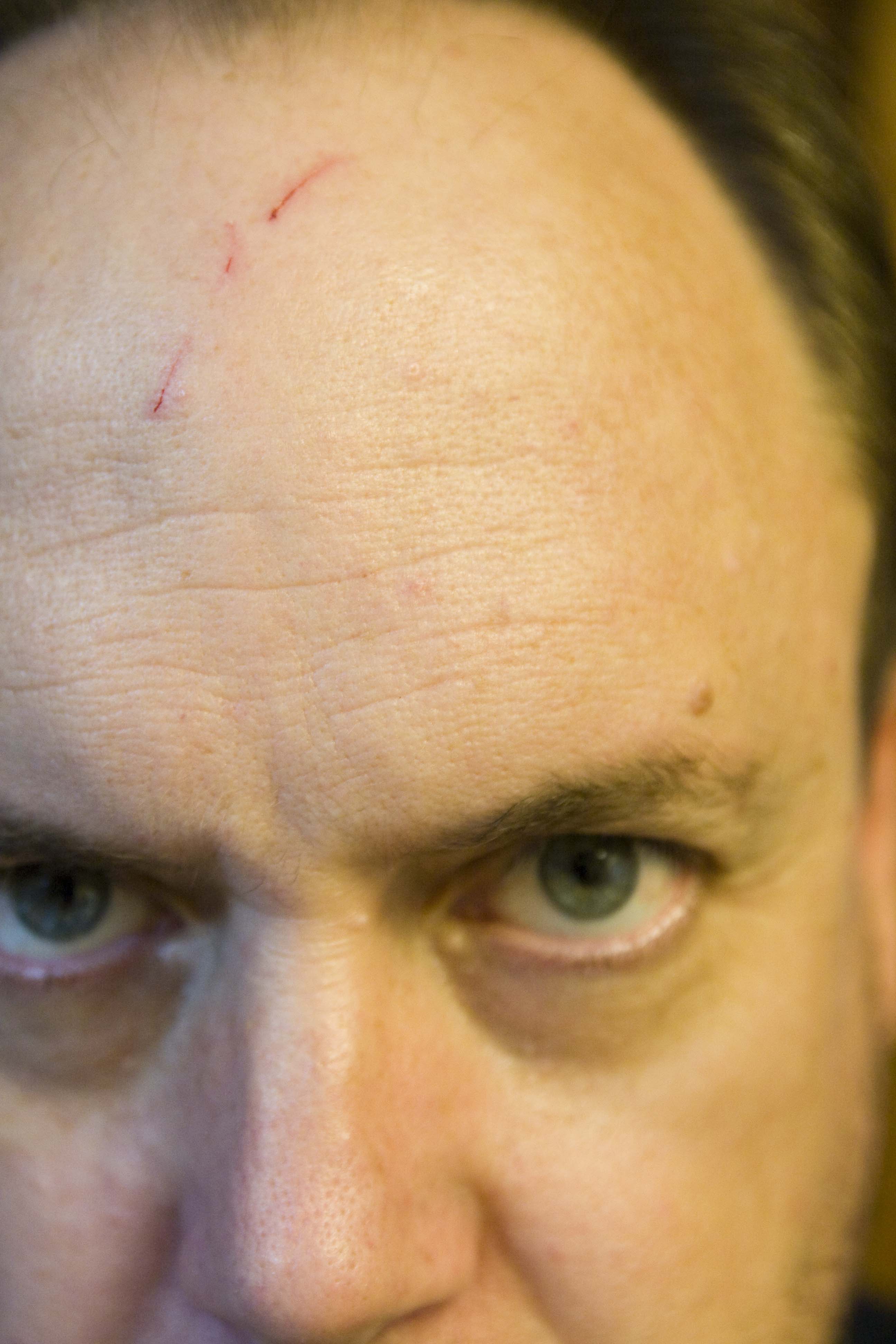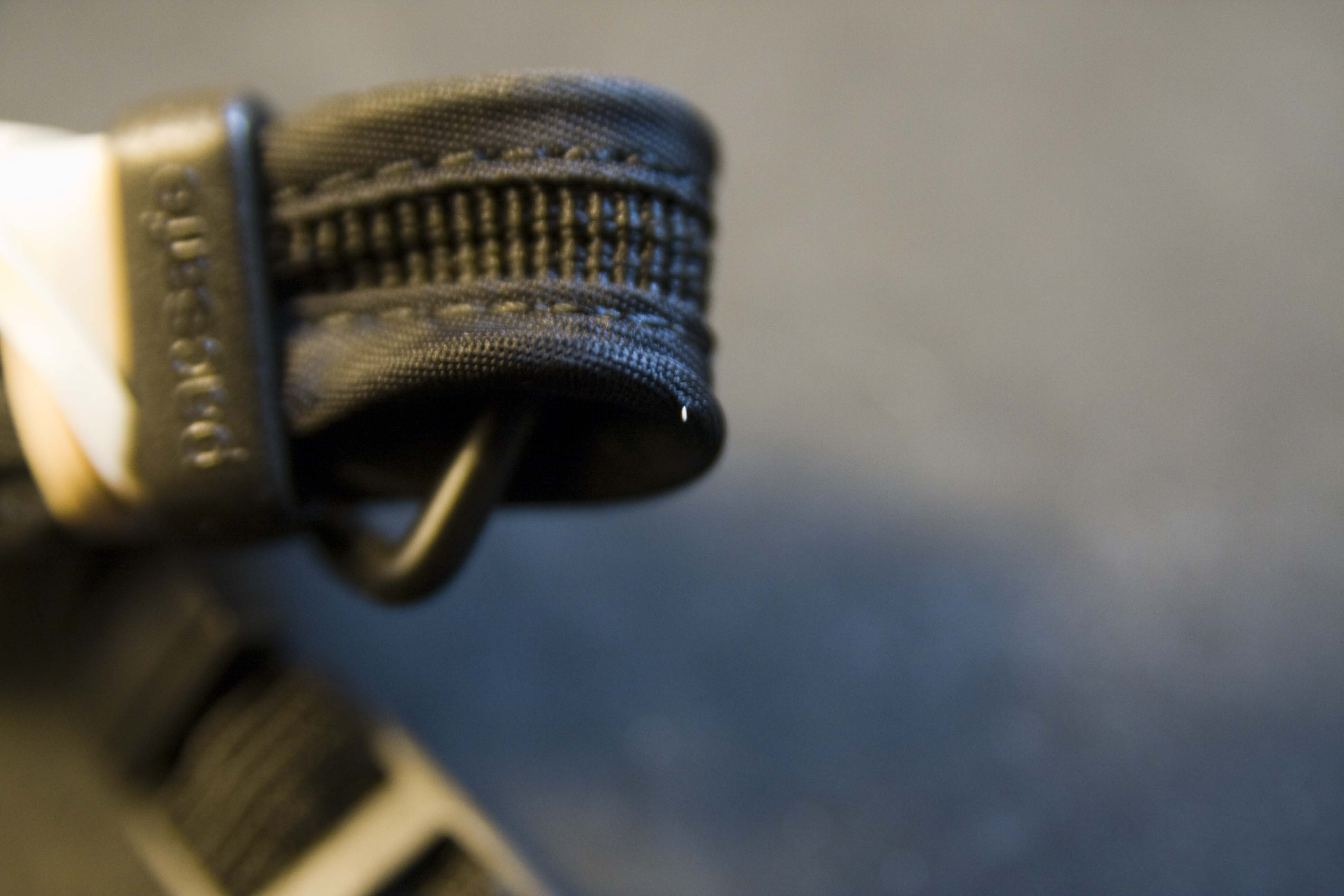In this article I talked about how useful the PacSafe straps were. I still feel this way, but I discovered that there is a trade-off in the design.
 (click any image for full size) The problem is flexibility. In order to make a strap flexible, it needs to use a wire rope that it made of lots of thin strands. The problem is that with these small strands, they will break off of the rope. A good design anticipates this and either coats the wire rope in plastic, or covers the rope in a material that the little strands can’t poke through. Unfortunately, neither of these precautions exist in the PacSafe CarrySafe 100 camera strap.
(click any image for full size) The problem is flexibility. In order to make a strap flexible, it needs to use a wire rope that it made of lots of thin strands. The problem is that with these small strands, they will break off of the rope. A good design anticipates this and either coats the wire rope in plastic, or covers the rope in a material that the little strands can’t poke through. Unfortunately, neither of these precautions exist in the PacSafe CarrySafe 100 camera strap.
Right where the strap has to make a 180 degree turn, it is most vulnerable to fraying. When this happens, you will bring the very thin wire strand across whatever part of your body it is closest to. It is so small that you will never notice it-until it cuts your skin. And fray it did:
 Now this is not an expensive strap, and surely these concessions were made to keep them affordable. I appreciate the fact that a photographer can get accessories as handy as these without paying as much as we do for a lens. But surely this was a design flaw that was known as soon as they made them. In fact, PacSafe knows of this design flaw and has posted how to deal with it-after it fails. In the warranty it clearly addresses the problem thus:
Now this is not an expensive strap, and surely these concessions were made to keep them affordable. I appreciate the fact that a photographer can get accessories as handy as these without paying as much as we do for a lens. But surely this was a design flaw that was known as soon as they made them. In fact, PacSafe knows of this design flaw and has posted how to deal with it-after it fails. In the warranty it clearly addresses the problem thus:
PacSafe:
“Burs and kinks in the wiring are not covered within this warranty. During the course of normal use some burring may occur. If a bur does appear, simply run the back edge of one of your keys rapidly back and forth across the bur at right angles to the length of the wire, the bur will disappear. Under some circumstances the wire may kink. If this occurs simply bend the wire in the opposite direction to the kink and it will straighten.”
Now don’t get me wrong, I really like these straps, and doubt you can buy a better one. That said, I think this design is 90% there. I also like the support. I get a direct email from a person who is a native English speaker. That is VERY rare. They also offered to replace the entire strap if I couldn’t “fix” it with a key.
PacSafe:
“You can use a key, a coin or whatever which is flat and strong enough to rub back and forth across the bur.
The purpose of doing it is to break off the wire inside the strap. In that way, you wouldn’t be able to hurt yourself again.”
So, being a good consumer I wrote back with some constructive criticism to get the strap up to 100% useful and safe:
Pat:
“Suggestion
1. Why not just coat the cable with plastic (as is customary), so that when the (inevitable) “burring”, or when a wire breaks free of the strand, it remains within the plastic sheathing? I suggested this in my last email.I understand that the smaller wires are needed for flexibility (and to reduce the amount of material needed for weight and cost reasons), but there is a trade-off to this design, and I think we found it. The straps are cheap enough today that dipping the strands would only add a few dollars at most to the consumer price.
Concern
2. If you think about it, the fraying of one wire in the strand makes the likelihood of the next strand breaking that must higher, right? After all, where once there were X number of strands taking the pressure, there are not X – 1. Do you follow my logic? So obviously, the objective is to break NO wires within each strand.And there you are, right back at the crossroads of flexibility and strength. A choice you made early on when you first designed the system.
Looking Forward
3. Looking at where the wire broke from the strand, you can easily see the problem. The strand is asked to make a sharp 180 degree turn in a short space. Then, at the weakest portion of that 180 it is asked to take all the load. Sounds liek a design problem from the start, doesn’t it? Of course we all know why it is this way-to make the strap adjustable.So the question now becomes “If we don’t dip the strands, how can we make a system that is adjustable, yet yields no sharp turns for the strand where it will break?”.
Now we’re actually getting somewhere, eh? :) Can we design a termination for the strand that protects it (and the user’s forehead) from damage, yet allow it to be adjusted throughout a reasonable range?
These are the things of patents, so I’ll leave that question to you for now, and not go much further until you (or engineering) reply…
Thanks for the advice on breaking off the wire… until the next one cuts me! :)”
Deprecated: Function get_magic_quotes_gpc() is deprecated in /homepages/16/d105165054/htdocs/atcp.us/blog/wp-includes/formatting.php on line 4819


Deprecated: Function get_magic_quotes_gpc() is deprecated in /homepages/16/d105165054/htdocs/atcp.us/blog/wp-includes/formatting.php on line 4819
Deprecated: Function get_magic_quotes_gpc() is deprecated in /homepages/16/d105165054/htdocs/atcp.us/blog/wp-includes/formatting.php on line 4819
Deprecated: Function get_magic_quotes_gpc() is deprecated in /homepages/16/d105165054/htdocs/atcp.us/blog/wp-includes/formatting.php on line 4819